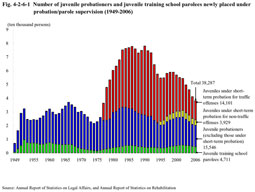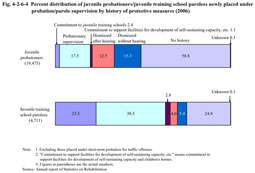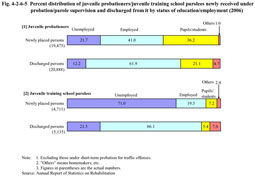| Previous Next Index Image Index Year Selection | |
|
|
1 Juvenile probationers/juvenile training school parolees
(1) Number of juveniles newly placed under probation/parole supervision
Fig. 4-2-6-1 shows the number of juvenile probationers and juvenile training school parolees newly placed under probation since 1949. Fig. 4-2-6-1 Number of juvenile probationers and juvenile training school parolees newly placed under probation/parole supervision (1949-2006) The number of juvenile probationers and juvenile training school parolees newly placed under probation/parole supervision recorded the highest number of 78,112 in 1990, but decreased from 1991 to 1995. Then, it increased slightly from 1996 to 1999, but again it has been on a downward trend since 2000 (see Appendix 2-12).Looking at the breakdown of juvenile probationers and juvenile training school parolees newly placed under probation/parole supervision in 2006, there were 33,576 juvenile probationers (a decrease of 2,684 juveniles (7.4%) from the previous year) and 4,711 juvenile training school parolees (a decrease of 175 juveniles (3.6%) from the previous year). There are short-term probation for non-traffic offenses and short-term probation for traffic offenses determined by recommendation concerning treatment by a family court. a. Short-term probation for non-traffic offenses Short-term probation for non-traffic offenses is for a juvenile who is placed under probation by a family court order for any offense other than traffic-related ones (dangerous driving causing death or injury, negligence in the pursuit of social activities in traffic accidents, violations of four statute traffic related acts, and Road Trucking Act violations; see Part 1, Chapter 3, Section1, 4 for amendment of traffic-related acts; hereinafter the same in this section) as long as the juvenile has not developed strong delinquent tendencies and is expected to improve and rehabilitate him/herself during the short-term period. This has been conducted since 1994. Short-term probation for non-traffic offenses lasts for a short period of six or seven months in principle, during which treatment is conducted by giving guidance on particularly important fields for a juvenile's rehabilitation, such as on his/her lifestyle, school life, employment, family relationships or friend relationships. Some assignments are given for him/her to perform, designed to help him/her solve their problems in such fields. b. Short-term probation for traffic offenses Short-term probation for traffic offenses is for a juvenile who is placed under probation by a family court order for traffic-related offenses as long as the juvenile does not have general delinquent tendencies or has not developed strong delinquent tendencies and his/her traffic-related delinquent tendencies are not fixed. This has been conducted since 1977. Short-term probation for traffic offenses lasts for a short period of three or four months in principle. Instead of ordinary treatment, group treatment concerning safe driving is conducted. (2) Characteristics of juvenile probationers/juvenile training school parolees a. Age Fig. 4-2-6-2 shows the age distribution of juvenile probationers/juvenile training school parolees newly placed under probation /parole supervision (excluding juveniles under short-term probation for traffic offenses; hereinafter the same in this section) in 2006. Fig. 4-2-6-2 Age distribution of juvenile probationers/juvenile training school parolees newly placed under probation/parole supervision (2006) Compared to juvenile training school parolees released from juvenile training schools, the percentage of younger juvenile probationers is high.b. Type of delinquency Fig. 4-2-6-3 shows the percent distribution of juvenile probationers/juvenile training school parolees newly placed under probation/parole supervision in 2006, by sex and by type of delinquency. Fig. 4-2-6-3 Percent distribution of juvenile probationers/juvenile training school parolees newly placed under probation/parole supervision, by sex and by type of delinquency (2006) c. History of protective measures Fig. 4-2-6-4 shows percent distribution of juvenile probationers/juvenile training school parolees newly placed under probation in 2006, by history of protective measures. Fig. 4-2-6-4 Percent distribution of juvenile probationers/juvenile training school parolees newly placed under probation/parole supervision by history of protective measures (2006) d. Education or employment status Fig. 4-2-6-5 shows the percent distribution of juvenile probationers/juvenile training school parolees newly placed under probation/parole supervision and discharged from it (excluding those under short-term probation for traffic offenses; hereinafter the same in this section) in 2006, by status of education or employment. Fig. 4-2-6-5 Percent distribution of juvenile probationers/juvenile training school parolees newly received under probation/parole supervision and discharged from it by status of education/employment (2006) It is difficult to make a strict comparison of the employment status on juvenile probationers and juvenile training school parolees who are newly placed under and discharged from probation/parole supervision for each year, as the juveniles who are the subject are not the same. However, when compared with the time when probationers/parolees are placed under probation/parole supervision, the percent ratio of juveniles who are employed is higher for both probationers and parolees at the time they are discharged from probation/parole supervision. However, 12.2% of total juvenile probationers and 21.5% of total juvenile training school parolees were discharged from probation/parole supervision, unemployed. |




